Wartime Magazine Issue 44 - Book reviews
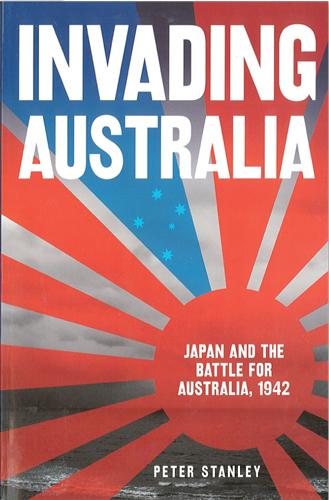
Invading Australia: Japan and the battle for Australia, 1942
Peter Stanley, Viking, 2008, $35
This is not your usual military history book, if indeed there is such a thing. It is not a narrative or analysis of a particular military campaign, battle or person. Rather, as Peter Stanley declares, the book “is an argument about our history and who it belongs to”. Of course, there is plenty of historical narrative and analysis, but essentially the book is Stanley’s contribution to the debate about how Australian history is interpreted and used.
The centrepiece is the question of whether Japan planned to invade Australia in the Second World War. Stanley, who was principal historian at the Australian War Memorial until he moved to the National Museum of Australia in 2007, argues that the Japanese high command never had an agreed and approved plan to invade Australia. Stanley’s critics tend to agree on this point, and both also agree that certain senior Japanese naval officers wanted to invade Australia but failed to win the argument in Tokyo. At this point, however, Stanley parts company with his critics, who argue that the Japanese wanted to take control of Australia and would have done so if given the opportunity: Australia was therefore in real and imminent peril. So in this respect the argument revolves around the phrase “planned to invade”.
Another argument concerns the word “threat”. One critic claims that Stanley’s book is the culmination of his “campaign to deny that there was ever a threat to Australia from Japan”. In reply Stanley states unequivocally, “I don’t say Japan wasn’t a threat to Australia: it was. But it was a threat because it sought to conquer Southeast Asia (and almost succeeded) not because it made plans to invade Australia.”
While this argument is central to the book, it also goes on to explain why many Australians believed and continue to believe that their nation was in danger from invasion. Stanley argues that there are broadly three reasons for this belief. First, by 1941 Australians had a long standing fear of a Japanese invasion, stemming from the Sino-Japanese War of 1894–5. The subsequent publication of a series of novels and other books over the next half-century fostered the idea of the “yellow peril”. He spends considerable space outlining the plots of these novels.
Second, Government wartime propaganda, supported by statements by Prime Minister John Curtin, was designed to encourage Australians to fight and work to prevent a Japanese invasion, even after the likelihood had passed. This propaganda had a deep and lasting effect on the Australians who lived through this period.
And third, as the years have passed, many Australians have wanted to believe that they had taken part in one of the great episodes in Australian history, namely the fight toprevent the invasion. For this latter reason, Stanley claims, these Australians have sought to commemorate the battle for Australia – a battle which Stanley states did not take place. Provocatively, Stanley describes this desire for recognition as “pathetic”.
A short review cannot do justice to all sides of the argument. I first set out my own views in my 1978 book, Crisis of command, when I wrote, “The Japanese High Command never really agreed to invade Australia”, and noted also that in June 1942 General Douglas MacArthur advised Curtin that Australia’s defence position was now secured. I repeated these views in subsequent publications and for some reason was never criticised for expressing them.
Stanley presents a well-argued and persuasive case, but there are some weaknesses. Sloppy editing has put the footnotes for the Prologue in Chapter One, and the map numbers are mixed up. There are also some minor errors: for example, the 39th Battalion did not march back over the mountains in November 1942 – it flew.
These minor errors do not detract from the main thesis. Full of interesting commentary, this is an engaging book that will provoke argument. Through it, Stanley has provided a considerable service to the understanding of Australian history. Unfortunately, as he recounts, many of his critics have resorted to personal attacks. His book deserves to be read and debated on the basis of the historical argument presented in it.
David Horner

Down to earth: a fighter pilot’s experiences of surviving Dunkirk, the Battle of Britain, Dieppe and D-Day
Squadron Leader K.B. McGlashan and Owen Zupp, Grub Street, 2007, $49.99
Kenneth McGlashan saw key events in the air war, from Dunkirk to the vast D-Day operations, as a participant. His story, sympathetically told by Owen Zupp, is full of the sort of details that official accounts do not contain: the visual, aural and emotional experience of war in the air, woven in with the routines (and disruptions) of squadron life. Zupp also ensures that the larger picture is present, and that personal events can be seen in context. McGlashan went on to a postwar career in the RAF and finally settled in Australia. Down to earth is a valuable and insightful account.

The forgotten few: 77 RAAF Squadron in Korea
Doug Hurst, Allen and Unwin, 2008, $29.95
Doug Hurst’s new book on 77 Squadron in Korea, The forgotten few, is a significant work on a key part of the Australian experience of that complex war. As the author points out, previous accounts have had deficiencies, including the absence of the Soviet Union as a major player in the air aspects of the conflict. This is a work that is not afraid of detail, and indeed uses it to good effect.
It also makes great use of the personal accounts of the airmen who were there and is fair in presenting their often diverse views – for example, when it covers the relative merits of the Gloster Meteor fighter. For a single squadron, the views and stories of the main players are important matters. Hurst has had the opportunity to speak at length with many of them, including the late Dick Cresswell. Hurst’s aim – to tell what happened to the squadron and why – is achieved in this fascinating book. - John White
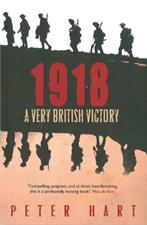
1918: a very British victory
Peter Hart Weidenfeld and Nicolson, 2008, $60
At the end of the First World War, it can be rightly said that the British Army – for the first and only time in its history – was the dominant military force in the world. Peter Hart tells the story of this army and how it was able to claim its “very British victory” in 1918.
The British developed a style of fighting that combined giving Lewis machine-guns to the infantry to increase their firepower, deploying large numbers of tanks and artillery, and developing scientific methods to locate the positions of German artillery batteries so they could be bombarded at the start of the attack to prevent their firing on the advancing troops.
Hart, who works at the Imperial War Museum London, uses hundreds of personal accounts by the individuals involved – British, Irish, Canadian and Australian, for the British Army in 1918 was a British Empire Army – to bring his book to life. The only criticism that must be made is that the index contains many errors which appear to be the result of using indexing software that was not quite up to the task.
John Connor
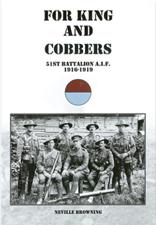
For King and cobbers: the history of the 51st Battalion AIF 1916–1919
Neville Browning, Neville Browning, 2007,$70
In 2000, Neville Browning published a small book called Fix bayonets: the history of the 51st Battalion, AIF. Modest in format, it contained a fairly bald account of the battalion’s doings in the First World War, based largely on the unit diary. A tireless champion of the Western Australian AIF units, Browning has since published several other histories. Evidently not satisfied with his first study of the 51st Battalion, he has now produced For King and cobbers as a replacement.
All that need be said of this completely new book is that it improves on the original in every way. Better writing, better production, better rolls and overwhelmingly better picture quality mean that the 51st now has a history which bears comparison with any of the modern unit publications. There are some odd moments (Generals Sir Arthur Murray and Sir Arthur Godley, rather than Sir Archibald and Sir Alexander) but overall the account is excellent, particularly in examining seldom discussed battles such asNoreuil in April 1917.
Nick Fletcher
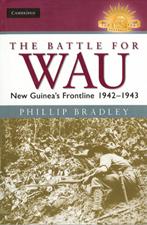
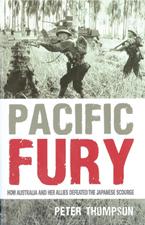
Pacific fury: how Australia and her Allies defeated the Japanese scourge
Peter Thompson William Heinemann, 2008, $54.95
The battle for Wau: New Guinea’s frontline 1942–1943
Phillip Bradley Cambridge University Press, 2008, $75 (hardcover)
Throughout 1942 and 1943, the rugged terrain around Salamaua and Wau was the scene of desperate fighting as Australian and Japanese forces struggled for control of the area. It was the scene of the first Allied offensive against the Japanese in New Guinea, when Captain Norm Winning led members of the 2/5th Independent Company in a daring commando raid against the Japanese at Salamaua, on the Huon Gulf during the night of 28–29 June 1942. However, the details of this campaign are little known or remembered today.
Indeed, Australia’s Pacific campaigns, except for Kokoda, have received little serious attention apart from the official histories published several decades ago. This lack of attention has acutely been described as a “green hole”.
One historian doing his best to rectify this is Phillip Bradley. In The battle for Wau Bradley, who previously wrote the excellent On Shaggy Ridge, has written a very detailed account of the first part of the New Guinea offensive, from the Japanese landing at Salamaua in March 1942 through to their defeat at Wau in February 1943.
Using the same methodology as his first book, Bradley has examined extensive archival material and interviewed more than 70 veterans. He is able to skilfully interweave his firsthand knowledge and understandingof the ground into the narrative. Bradley is also to be commended for arranging for the translation of sections of the Senshi sosho, the Japanese official history, which provides an accurate insight into the actions and intentions of the Japanese commanders.
The battle for Wau also marks the welcome return of the Australian Army History Series which had been in abeyance. The text is well illustrated with terrific maps. The book is expensive, but it deserves to be widely read. Readers will not be disappointed.
Following the 1943 New Guinea offensive, the Australian army was withdrawn from New Guinea to await a new task. The army did not take to the field again until late 1944 and 1945, when it conducted offensive operations in New Guinea and Bougainville, and on Borneo towards the end of the war. Because Australian forces were no longer at the forefront of operations to defeat Japan, some British and American historians have subsequently criticised Australia’s efforts during the Pacific war.
Peter Thompson, a British-based Australian journalist, certainly felt as though Australian forces have been slighted, particularly following the publication of Max Hastings’s controversial Nemesis (see Wartime 42). This led to him to write Pacific fury in an attempt to place Australia’s contribution in the broader context of the Allies’ effort.
Trying to cover all of the Pacific war in a single volume was always going to be ambitious. Thompson’s approach works well at times. He paints an intriguing picture of colonial life for expatriates in Singapore and Hong Kong, for example, while his chapter on the battle of Savo Island, where HMAS Canberra and USS Chicago were lost in August 1942, is vividly described. At other times, his chronological narrative becomes lost in a host of names and disparate events.
The real problem with this book, though, is that it concentrates on Japan’s path to war and the climatic events of 1942. The campaigns from 1943, when Australian and her allies actually go on the offensive and defeat Japan, receive insufficient attention; and in making this choice, Thompson does not address the assertions made by Hastings and the like. Consequently, it will probably be Hastings’s views that will have more of a lasting effect.
Karl James
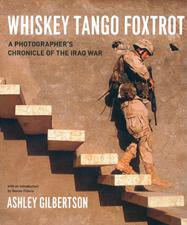
Whiskey tango foxtrot: a photographer’s chronicle of the Iraq war
Ashley Gilbertson The University of Chicago Press, 2007, $60
“Being a spectator of calamities taking place in another country is a quintessentially modern experience,” wrote Susan Sontag. True enough, so much of contemporary visual culture traffics in the pain of others, viewed with the safety of distance. For Sontag, this was a problem: it left us numb, and inured us to the truth of pain and suffering.
How to cut through this modern predicament seems to be the intention of the Australian photographer Ashley Gilbertson’s new book. It presents a detailed account of Gilbertson’s experience of the Iraq war, in photographs taken over a two-year period. The book’s images are organised into five sequences, each introduced with a highly personal essay by Gilbertson. The best of these chapters describes 2004’s battle of Falluja, when Gilbertson photographed the efforts of B Company, 1st Battalion, 8th Regiment, to reclaim the town from insurgents. The photographs are full of chaos and madness, as Gilbertson’s camera closely follows the company through the town.
Many of these photographs have been seen before, in the pages of the New York Times and Time magazine, among others. They have become an inseparable part of the politics of the war, especially as it is played out in the media. Gilbertson disentangles his images from this politics by inserting himself squarely in the frame. These are no longer simply pictures of contemporary life in Iraq; nor are they journalistic illustrations of the events of war. In Whiskey tango foxtrot, the images are part of one person’s particular experience of Iraq and its problems. This was an experience that, as the text makes clear, left the photographer deeply scarred: scarred by the experience of being part of a picture-making machine; scarred by the deaths of seven of the men he photographed at Falluja, including one of his escorts.
Images of “calamity” and the trauma of the experience of war are brought together through text and photographs in an account that is both affecting and, for those of us “in another country”, highly instructive.
Shaune Lakin
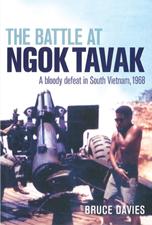
The battle at Ngok Tavak: a bloody defeat in South Vietnam, 1968
Bruce Davies Allen and Unwin, 2008, $29.95
On 10 May 1968, in the western jungle of Vietnam, a Special Forces company commanded by an Australian Army captain came under attack from North Vietnamese Army soldiers in what became known as the battle at Ngok Tavak. Within hours the Special Forces survivors had retreated from the site, an old French fort, leaving behind the bodies of 11 American Marines and a Special Forces sergeant; an American medic was missing.
The story of this battle is one of poor planning and supply, contradictory orders, confusion, bravery and, ultimately, tragedy. That any members of the Special Forces company managed to escape unscathed is ue to good leadership and the courage of all who fought. Bruce Davies has meticulously researched events leading up to the battle, the unfolding of the battle itself and its aftermath. He writes with great compassion and understanding of the struggles by survivors, and by the relatives of those who died, to have the true story of the battle revealed.
In the final section of the book, Davies deals skilfully with the long and involved process undertaken by American Vietnam veteran groups to have the battle site thoroughly excavated for human remains, putting an end to the long quest for answers about what happened to the Marines left behind.
The battle at Ngok Tavak is a compelling read and the author should be congratulated for his efforts to reveal the truth about one of the most bitter, but least known, battles of the Vietnam War.
Elizabeth Stewart